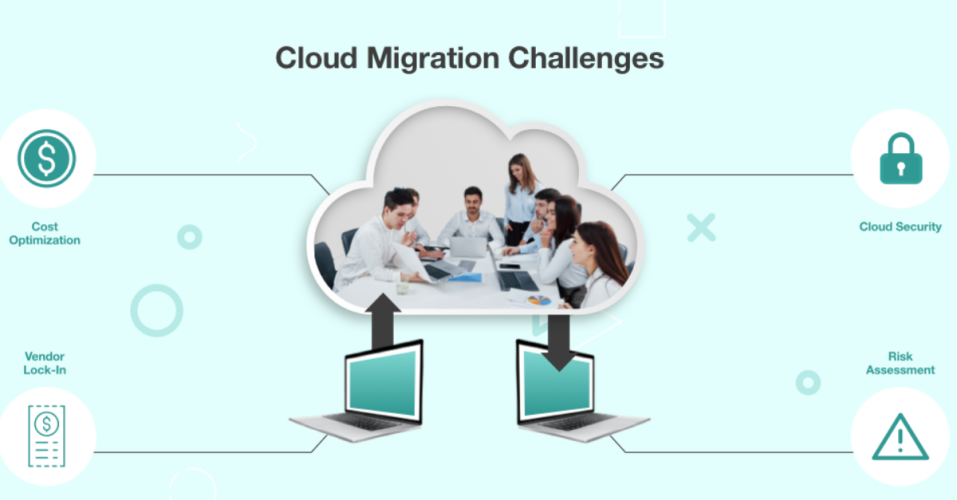What are the Key Cloud Migration Challenges & How to Overcome Them?

Introduction
Cloud migration is a difficult process that requires careful planning and time. It’s not uncommon for companies to spend months migrating from on-premises to the cloud, but once your workloads are up and running in the new environment, you’ll be able to enjoy many benefits.
Challenges of Server Migration
It’s a big decision, and there are many things that you need to consider before you make it. The most important thing is to know the risks involved in cloud migration. For example, if your data center fails during the migration process, then all of your data will be lost forever! It’s important for your organization and for yourself as well because if something goes wrong during this process then it could cost millions of dollars in damages due to downtime or lost revenue because customers can’t access their websites through services like Google Analytics etc..
The second thing that people often forget about when moving from on-premises server migration to cloud is how easy it is for them (and their IT staff).
to manage these new environments instead of dealing with maintenance tasks like patching software updates manually every week – which may take days or even weeks depending on what type of system they’re working with today.”
Difficulties with moving your workloads to Cloud.
There are many cloud migration challenges that you need to overcome in order to successfully move your workloads to the Cloud.
- Hardware – The first challenge is hardware, which includes everything from laptops and servers all the way down to your network switches and routers. You will have issues with compatibility between hardware from different manufacturers, as well as hardware upgrades required after migrating into the Cloud (e.g., adding additional memory).
- Software – This includes applications running on-premises or in private clouds (such as SAP) before moving them into public clouds such as AWS or Azure SQL Database (Azure SQL DB).
Upgrading Hardware in a Hybrid Environment
There are many challenges when upgrading hardware in a hybrid environment. For example, it is difficult to upgrade hardware in a hybrid environment because of the dependencies among various systems and applications. In addition, you need to be careful when upgrading your infrastructure as it can impact other parts of your business process. To overcome these challenges and make sure that you don’t miss any opportunities for innovation or growth, we recommend implementing an automated testing framework such as TestRail so that developers can easily test their code before releasing it into production environments.
Handle VMs, Storage and other infrastructure services
VMs are the building blocks of a cloud environment. They host applications, data and other workloads. The VM instances are managed by an Orchestration Service (OS) and can be hosted on either public or private clouds.
Storage is an important aspect of moving to the cloud since it allows users to store their existing data in a centralized location while they move it between different providers’ clouds as needed. This reduces costs by eliminating duplication and saves time by not having to re-architect each new server deployment from scratches every time you want to add more storage capacity or relocate entire sets of servers from one datacenter location to another one nearby within your own premises network.
Managing the Clients in a Cloud Environment
- How to Manage Clients in a Cloud Environment
- How to Manage Clients in a Hybrid Environment
- How to Manage Clients in a Private Cloud Environment
- How to Manage Clients in a Public Cloud Environment
Maintaining Compliance and Security
Compliance and security are often conflicting, but there are a number of cloud providers that can help you meet your compliance requirements. Some of these services include:
- Data loss prevention (DLP) – a technology that detects, prevents and responds to sensitive data loss incidents.
- Endpoint security – protects against unauthorized access to devices and networks through antivirus software, firewalls and encryption protocols.
- Identity and Access Management (IAM) – automates the management of users’ identities in an organization’s data centers as well as those on its external networks.[1]
Learn how to overcome the challenges when migrating from physical to cloud.
How to overcome the challenges when migrating from physical to cloud?
The first step is to understand the difference between the two, which can be done by taking a look at this graphic:
- Physical infrastructure – The physical infrastructure consists of devices and systems that are located in one location. These include servers, storage devices, networking equipment and other IT assets. These items are all connected together with cables or wireless connections (Wi-Fi). They also need power supplies for running their operations properly.
- Cloud Infrastructure – The cloud infrastructure refers to an environment where multiple users share resources on demand through virtualized computers hosted by third party providers like Amazon Web Services (AWS), Microsoft Azure etc., who operate them remotely from different locations under various conditions such as weather conditions etc., while they don’t have any direct relationship between them except those provided by their owners/administrators using remote access software such as Teamviewer or GoToMyPC software installed on each client PC device.
Conclusion
In today’s world, it is difficult to find a company which can provide you with the best services. You need to make sure that your company is well-equipped to handle all of its tasks related to cloud migration and ensure that it has the infrastructure in place for future growth. This will help you keep up with the demands of modern technology without having any downtime or downtime at all!
